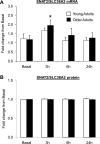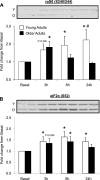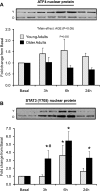Skeletal muscle amino acid transporter expression is increased in young and older adults following resistance exercise
- PMID: 21527663
- PMCID: PMC3137547
- DOI: 10.1152/japplphysiol.01408.2010
Skeletal muscle amino acid transporter expression is increased in young and older adults following resistance exercise
Abstract
Amino acid transporters and mammalian target of rapamycin complex 1 (mTORC1) signaling are important contributors to muscle protein anabolism. Aging is associated with reduced mTORC1 signaling following resistance exercise, but the role of amino acid transporters is unknown. Young (n = 13; 28 ± 2 yr) and older (n = 13; 68 ± 2 yr) subjects performed a bout of resistance exercise. Skeletal muscle biopsies (vastus lateralis) were obtained at basal and 3, 6, and 24 h postexercise and were analyzed for amino acid transporter mRNA and protein expression and regulators of amino acid transporter transcription utilizing real-time PCR and Western blotting. We found that basal amino acid transporter expression was similar in young and older adults (P > 0.05). Exercise increased L-type amino acid transporter 1/solute-linked carrier (SLC) 7A5, CD98/SLC3A2, sodium-coupled neutral amino acid transporter 2/SLC38A2, proton-assisted amino acid transporter 1/SLC36A1, and cationic amino acid transporter 1/SLC7A1 mRNA expression in both young and older adults (P < 0.05). L-type amino acid transporter 1 and CD98 protein increased only in younger adults (P < 0.05). eukaryotic initiation factor 2 α-subunit (S52) increased similarly in young and older adults postexercise (P < 0.05). Ribosomal protein S6 (S240/244) and activating transcription factor 4 nuclear protein expression tended to be higher in the young, while nuclear signal transducer and activator of transcription 3 (STAT3) (Y705) was higher in the older subjects postexercise (P < 0.05). These results suggest that the rapid upregulation of amino acid transporter expression following resistance exercise may be regulated differently between the age groups, but involves a combination of mTORC1, activating transcription factor 4, eukaryotic initiation factor 2 α-subunit, and STAT3. We propose an increase in amino acid transporter expression may contribute to enhanced amino acid sensitivity following exercise in young and older adults. In older adults, the increased nuclear STAT3 phosphorylation may be indicative of an exercise-induced stress response, perhaps to export amino acids from muscle cells.
Figures






References
-
- Adams CM. Role of the transcription factor ATF4 in the anabolic actions of insulin and the anti-anabolic actions of glucocorticoids. J Biol Chem 282: 16744–16753, 2007 - PubMed
-
- Baird FE, Bett KJ, MacLean C, Tee AR, Hundal HS, Taylor PM. Tertiary active transport of amino acids reconstituted by coexpression of system A and L transporters in Xenopus oocytes. Am J Physiol Endocrinol Metab 297: E822–E829, 2009 - PubMed
-
- Bevington A, Brown J, Butler H, Govindji S, KMK, Sheridan K, Walls J. Impaired system A amino acid transport mimics the catabolic effects of acid in L6 cells. Eur J Clin Invest 32: 590–602, 2002 - PubMed
-
- Biolo G, Maggi SP, Williams BD, Tipton KD, Wolfe RR. Increased rates of muscle protein turnover and amino acid transport after resistance exercise in humans. Am J Physiol Endocrinol Metab 268: E514–E520, 1995 - PubMed
-
- Burd NA, West DW, Moore DR, Atherton PJ, Staples AW, Prior T, Tang JE, Rennie MJ, Baker SK, Phillips SM. Enhanced amino acid sensitivity of myofibrillar protein synthesis persists for up to 24 h after resistance exercise in young men. J Nutr 141: 568–573, 2011 - PubMed
Publication types
MeSH terms
Substances
Grants and funding
LinkOut - more resources
Full Text Sources
Other Literature Sources
Medical
Miscellaneous

